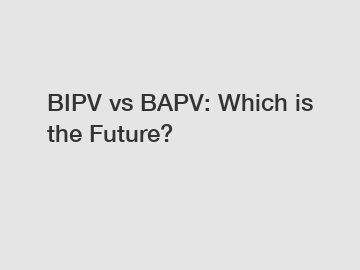Feb. 19, 2024
Energy
As the world continues to shift towards renewable energy sources, building-integrated photovoltaics (BIPV) and building-applied photovoltaics (BAPV) have emerged as promising options for generating solar power. Both technologies have their own set of benefits and drawbacks, but the question remains: which one is the future of solar energy in the building sector?
Benefits of BIPV.

Building-integrated photovoltaics are solar panels that are seamlessly integrated into a building's architecture. These panels can serve as roofing material, windows, or facades, providing both energy generation and structural support. One of the main benefits of BIPV is its aesthetic appeal. By blending into a building's design, BIPV can be more visually appealing than traditional solar panels mounted on top of a building. Additionally, BIPV can save space by replacing conventional building materials with solar panels, making it a popular choice for new construction projects.
Challenges of BIPV.
Despite its advantages, BIPV also faces some challenges. The cost of integrating solar panels into building materials can be higher than traditional solar panel installations. Additionally, the efficiency of BIPV panels may be lower due to constraints on their placement and orientation. Maintenance of BIPV systems can also be more difficult and costly, as repairs may require specialized knowledge and materials. These factors can make BIPV less feasible for some building projects.
Benefits of BAPV.
Building-applied photovoltaics, on the other hand, are solar panels that are installed on top of existing building structures. BAPV systems are easier to install and maintain than BIPV systems, making them a more cost-effective option for retrofitting existing buildings. BAPV panels can be mounted on roofs, awnings, or other structures, maximizing the available space for solar energy generation. This flexibility in installation allows BAPV systems to be customized to fit the needs of each building, making them a versatile option for a wide range of projects.
Challenges of BAPV.
While BAPV offers many advantages, it also has its own set of challenges. One of the main drawbacks of BAPV is its impact on a building's aesthetics. Solar panels mounted on top of a building can be more noticeable and less visually appealing than BIPV integrated into the building's design. Additionally, the installation of BAPV systems can be disruptive to building occupants, as it may require drilling or modifications to the existing structure. These factors can make BAPV less desirable for some building projects.
The Future of Solar Energy in Buildings.
So, which technology is the future of solar energy in the building sector? The answer may lie in a combination of BIPV and BAPV solutions. While BIPV offers a seamless integration of solar panels into a building's design, BAPV provides a cost-effective option for retrofitting existing structures. By leveraging the benefits of both technologies, building owners and developers can maximize the energy generation potential of their buildings while minimizing costs and disruptions.
In conclusion, the future of solar energy in buildings is likely to be a combination of BIPV and BAPV technologies. Each option has its own set of benefits and challenges, and the ideal solution will depend on the specific needs of the project. By considering the aesthetic, cost, and maintenance requirements of each technology, building owners can make an informed decision about which option is best for their building. Contact us to learn more about BIPV and BAPV solutions for your building project.
For more photovoltaic tilesinformation, please contact us. We will provide professional answers.
Previous: What are the 4 types of beverage?
Next: Should businesses rely on vde-ar-n 4105 pdf for purchasing decisions?
If you are interested in sending in a Guest Blogger Submission,welcome to write for us!
All Comments ( 0 )